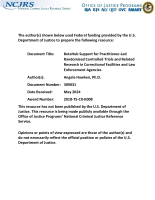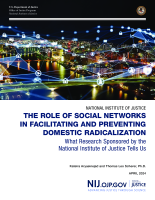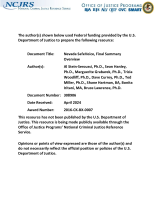Law enforcement
NIJ Journal No. 282 — Violent Crime
Ethical Data Sharing in Forensic Research
BetaHub Support for Practitioner-Led Randomized Controlled Trials and Related Research in Correctional Facilities and Law Enforcement Agencies
Drug-Impaired Driving: The Contribution of Emerging and Undertested Drugs
Forensic DNA Interpretation and Human Factors: Improving Practice Through a Systems Approach
Unconventional Wisdom: Research Shakes Up Assumptions About Sex Trafficking Clues in Online Escort Ads
Unconventional Wisdom: Research Shakes Up Assumptions About Sex Trafficking Clues in Online Escort Ads
Scientific study finds that many widely recognized indicators of trafficking in online escort ads are likely not reliable. Research also produces new practice guide.
Closing Cases Using Gunshot Residue
Closing Cases Using Gunshot Residue
Not every crime scene will have definitive evidence, such as DNA, to link an individual to a crime. In those cases, law enforcement relies on other evidence to build the burden of proof. NIJ graduate research fellow Dr. Shelby Khandasammy developed a tool to analyze organic gunshot residue and distinguish between different firearms calibers and manufacturers. She joins Marie Garcia, office director for the Office of Criminal Justice Systems at NIJ, to talk about her work and experience as a research fellow.
Death Investigation: A Guide for the Scene Investigator, 2024
From Research to Reality: Recruiting More Women into the Policing Profession: Preliminary Results of an NIJ-funded Applied Research Project
This webinar features the work of Dr. Jen Ranier, a research psychologist who studies workplace and workforce issues at RTI International. The project presented in this webinar had the goal of identifying ways to help law enforcement agencies recruit more women.
See the YouTube Terms of Service and Google Privacy Policy
Macro-Level Influences on Police Decision-Making and Engagement with Victims of Serious Violent Crime: A Narrative Case Study of Two States
Binge Drinking, Job Stressors, and Resilience in a Nationally Representative Sample of Law Enforcement Officers
The Role of Social Networks in Facilitating and Preventing Domestic Radicalization: What Research Sponsored by the National Institute of Justice Tells Us
Expert Testimony: Presenting Forensic Evidence in the Courtroom
Philosophies in Community Supervision of Gang-Involved Youth and Adults
Nevada SafeVoice, Final Summary Overview
Understanding the Trafficking of Children for the Purposes of Labor in the United States
The Daunting Task of Strengthening Medical Examiner and Coroner Investigations Across Hundreds of Jurisdictions
The Effect of Occupational Status on Health: Putting the Social in Socioeconomic Status
The Daunting Task of Strengthening Medical Examiner and Coroner Investigations Across Hundreds of Jurisdictions
After a five-year fact-finding mission, a multi-agency working group has identified a host of problems in the U.S. medical examiner/coroner system, but solutions remain elusive.







